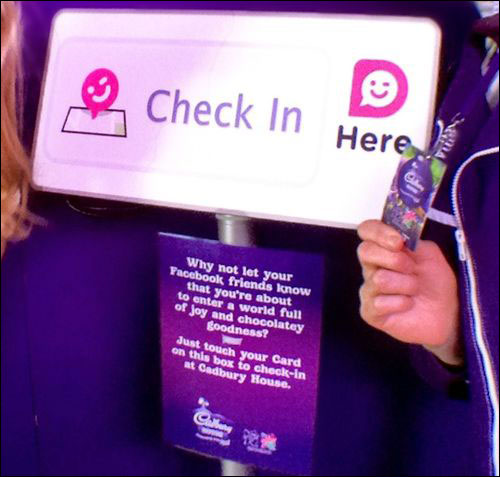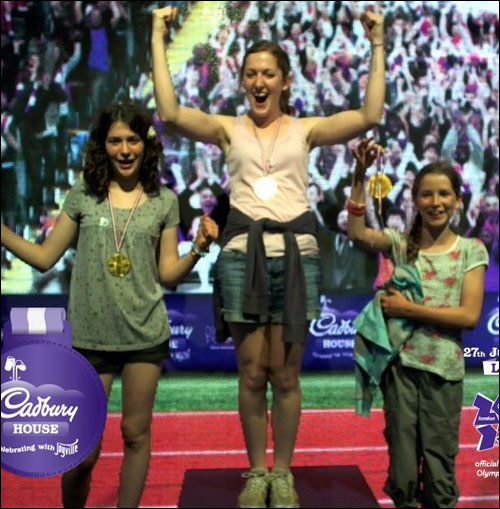Aug 03, 2012While athletes are demonstrating their prowess at the 2012 Summer Games, being held in London, Cadbury House is providing its own Olympic event in Hyde Park that includes RFID-enabled social-media sharing. There, confectionary company Cadbury provides visitors with a tour of its chocolate-making history. The system also allows visitors to easily link photographs of their visit with friends and family on their Facebook account, by means of a hands-free passive ultrahigh- frequency (UHF) RFID system created by Dwinq, a social-media technology company based in Massachusetts.
Cadbury, owned by Kraft Foods, is the "Official Treat Provider" of the London 2012 Olympic and Paralympic Games. As part of this role, says Sonia Carter, the head of Kraft Foods UK's digital division, the company erected a large, purple, inflatable structure known as Cadbury House, intended to provide "celebratory moments to enjoy, and magical chocolate wonderment."

"From the deliciousness of the Joyville Tasting zone experience to the magic of the Chocolatrium," Carter says, "we wanted to give visitors the opportunity to share the joy and magic of the experience with friends and family, there and then."
Since the 2012 Games began on July 27, Cadbury House has been receiving approximately 3,500 visitors daily. Guests come to view a museum-like exhibit of Cadbury's history, sample the company's confections, learn how chocolate is produced, play interactive games and share details about the visit with their Facebook friends, via RFID activation points.
The radio frequency identification solution that Dwinq designed differs from most RFID-enabled social-media technology, in that it allows users to send pictures and updates to their Facebook page without having to tap a card against a reader.
Prior to entering Cadbury House, a visitor is offered an ID badge supplied by Vanguard ID Systems. The badge, which contains an EPC Gen 2 passive UHF RFID tag, is worn around a person's neck on a lanyard. The visitor then register his or her Facebook account information, which is linked to the ID number encoded to the badge's RFID tag in Dwinq's software, explains Patrick Sweeney II, Dwinq's president and CEO. Upon entering the exhibit area, the guest can then check in by placing the badge next to a "check-in spot" with a ThingMagic reader built behind it.
In addition, a roving photographer carrying a UHF handheld reader supplied by IDBlue asks guests if they would like to share a picture. For those who agree to do so, the reporter places the reader near that person's badge, enabling it to capture the badge ID number and transmit that data, along with the picture, to Dwinq's social-media platform software, via a Wi-Fi connection.

Dwinq began developing the system about a year ago, says Sweeney, who launched the company while he was the CEO and president of RFID software and solutions provider ODIN, where he still serves as chairman. "Our goal was to make the social media as frictionless as possible," he states. To accomplish this goal, the company opted to utilize passive EPC Gen 2 UHF tags, with a longer read range than passive high-frequency (HF) RFID tags. He adds, however, that Dwinq's solution could function with HF tags and readers, though the challenge would be to ensure that with so many people crowded near a reader, the software would be able to screen out stray reads from badges not positioned directly in front of the camera.
The Dwinq software, Sweeney says, is what makes it possible to identify valid reads, versus strays. The software receives the ID numbers from all badges within its read range of several meters, and is then able to differentiate which badge is the one located in front of the digital camera, using algorithms that he declines to explain. He notes, however, that the interrogators deployed within Cadbury House capture hundreds of thousands of reads daily, which the software then must screen in order to determine which reads are relevant. "I can't tell you how proud I am of our engineering team," he says.
According to Carter, approximately 75 percent of Cadbury House's visitors opt to use the RFID solution to post pictures on their Facebook pages. "The system has been working brilliantly, and has been even more popular with visitors than we had hoped," she says. "Many have also been surprised about how easy it is to use the technology."
During the first two and half days of the system's use, Carter says, Cadbury House experienced 5,824 check-ins of new RFID badge users entering the exhibit, as well as 8,958 photo shares. Visitors can tour Cadbury House and use the Dwinq system at no charge.

